In a previous post entitled The Catfish Pond, I described one of the ponds located on this property, and discussed the problem of insufficient water clarity in that pond. Today’s post is about another pond on the opposite side of the ranch property. It is a spring-fed pond, so naturally we call it the “spring pond.” Whereas the catfish pond is plagued by insufficient water clarity, the spring pond is beset by insufficient water! This is a recent occurrence, and one which has us scratching our heads and wondering what course of action, if any, to take. To understand our dilemma, it is necessary to present a little background information.
The spring pond is fed by a small fresh water spring that, to my knowledge, has been steadily and reliably flowing for at least the past 3 decades. Below is a picture of the spring as it flows into the pond, which was taken April 10th of this year.
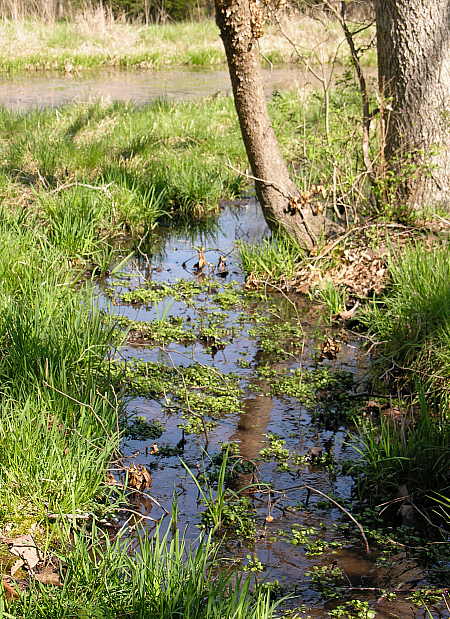
Although this is a small spring, it has provided an ample enough flow to keep the small spring pond full year round, even through the heat and dryness of our summers here in the Ozarks. Each spring and summer, the grasses in and around the pond will grow in abundance, and each winter the grasses and other vegetation die off, amassing as a thick organic matting on the pond floor. Over time, this organic matter had built up to the point that something needed to be done, lest the pond fill itself in and cease to exist at all. The photograph below, also taken on April 10th, show the condition of this small pond at the time –
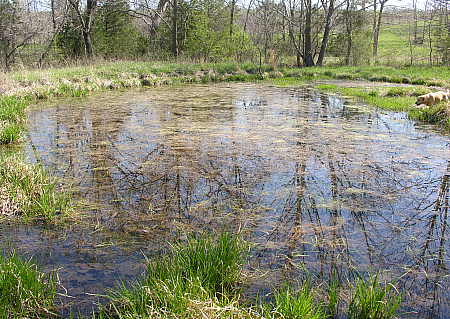
After examining the pond in April, Retta and I decided that we would schedule a pond cleaning for the spring of 2007, which would entail the services of an excavator and a bulldozer to dredge and reshape the pond to it’s previous spring-fed glory. In the meantime, I thought that I would introduce several grass carp (white amur) into the spring pond to see if they would help consume the excess grasses in the pond. We have had success with this method of pond vegetation control in yet another pond on our property (see The Grassing of the Carp), and we were confident that the carp would work in this pond as well.
When the local farm store scheduled a fish stocking day in early May, I was the first in line at the stocking truck to order my 4 grass carp. Returning to the ranch, I followed the recommended procedures for introducing and acclimating the carp into the spring-fed pond, and proceeded to forget about them for the time being. On July 2, roughly two months after introducing the carp into the pond, I decided it was time to check the progress of my experiment. Returning to the pond on July 2, this is what I found –
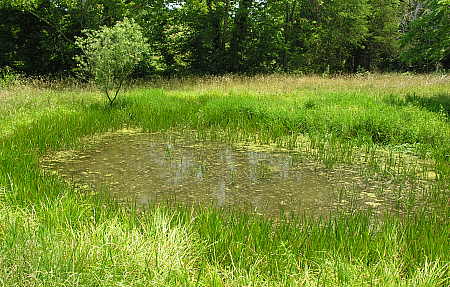
You can see in the photo above that the carp were doing their job, slowly but surely. In previous years, by July the grasses would have completely covered the entire pond surface, and so it was evident that the carp were making a big difference in the vegetative mass in the pond. Satisfied with the progress that the carp were making, I again put this pond out of my mind, and proceeded on with other tasks at hand.
It has been a little over a month since I last inspected the spring pond, so this morning (August 6) I thought it would be a good idea to mosey on over and see what was happening over there. The first sign that something was amiss is shown in the following photo –
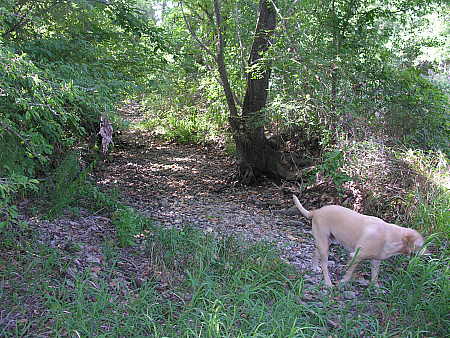
This creek bed is just below the outflow from the spring pond. It has been a reliable watering hole for the animals, as it has always been supplied with a fresh supply of water from the spring pond. As you (and George) can see, it is now bone-dry, as dry as dry can be.
Fearing the worst, I continued on over to the spring pond, and as you can infer from the following photo, I was not happy with what I saw. From the same vantage point as the previous photographs, you can see that the spring pond has shrunk to a fraction of it’s former size, and the spring itself can no longer replace water lost to evaporation.
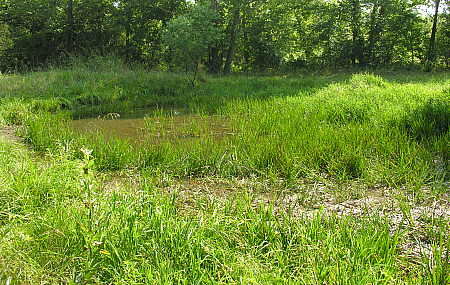
For what it’s worth, the carp still seem to be doing their job, as the following photograph shows that the remaining small amount of water left in the pond is clear of vegetation.
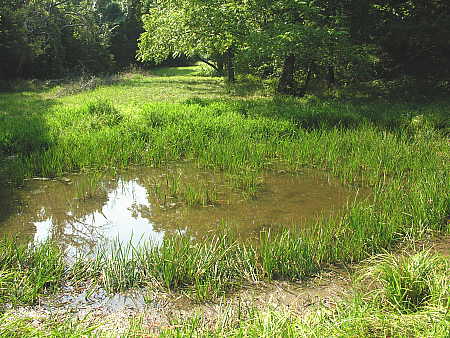
But I am doubtful that the pond will contain any water at all come September, unless something radical changes in the interim. The following photo shows the diminished flow coming from the spring, which can be compared to the very first photo in this post, which was taken this past April.
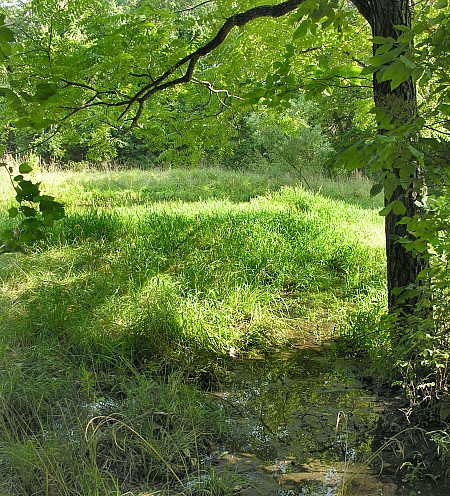
So now Retta and I face the dilemma – what to do with this pond? We had originally intended on hiring heavy equipment to visit our property for the purpose of cleaning out the pond. But if the spring itself is drying out, we will probably be wasting our time and limited resources undertaking this project. Is this spring experiencing a reduced water flow that is just a temporary aberration, or are we feeling some of the effects of global and regional temperature changes that are here to stay? Inquiring minds want to know!



I can offer no advice other than a wait and see approach. This may be a one-summer abberation. I’d say you should keep the rejuvenation plans in mind and watch how things develop over a few years. Then i’d say you have sufficient experience/data to make a decision. But that’s just me talking.
I feel your pond pain.
How nice to have a spring on the property tho.
I just discovered this blog post (a little late), however I am sorry to read about your spring dilema. I hope at this time your spring is flowing.
One thought if this happens again is a small well or diversion of other water.
I really like spring or flow thru ponds for their ease of care and more natural health due to nutrient availability.
I have just discovered your blog so I hope that this may still be a relevant response. The issue of the spring.
The good news is that you don’t have to worry about “global warming” as the culprit. It, like any other mythical bogeymen is well, mythical. Your spring however must have by definition a source, and that source can become compromised in several ways. One way is that the mouth can become clogged and therefore flow less freely, even to the point of no flow, especially in times of lower pressure such as the dry season. You might engage in a small excavation at the spring source to clear away any compaction, (perhaps due to animal traffic?) Another, more serious reason for diminished flow from your spring may be diversion. If someone higher up on the water table has tapped into the aquifer that sources this spring and is diverting the water, then you have a bigger problem that is no myth, man made, and will truly be here to stay, unless you can get the State or Feds to step in to force the perpetrator to restore preexisting conditions.
I’m having this same issue only on a less severe path of decline. How are things going for you now?
Jon – The flow of the spring has improved since this post, but the pond site would benefit from some work with an excavator.